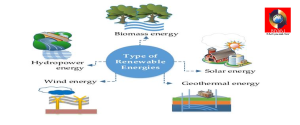Introduction
Renewable energy is increasingly at the centre of global action against climate change and transitioning to a cleaner energy system. Of all renewable sources, solar, wind, and hydropower are the most used. The viabilities and efficiencies of such resources, nevertheless, are strongly geography-dependent. Climate, topography, and resource availability dictate the sites where these technologies can be optimally utilized. This blog explains the geographical nature of solar, wind, and hydropower energy and how location impacts their utilization and impact.

Solar Energy and Geographic Distribution
Solar energy is generated through photovoltaic (PV) panels or concentrated solar power (CSP) plants. The place receives solar energy based on latitude, altitude, and climatic conditions in a region.
Key Geographic Solar Energy Factors
- Latitude and Solar Radiation: There is intense solar radiation near the equator, such as Northern Africa, the Middle East, and Australia. Countries with higher latitudes, like Canada and Scandinavia, experience less consistent sunshine.
- Cloud Cover and Climate: Deserts are the most favourable locations for solar farms due to low cloudiness and high sunshine. Example: Atacama Desert in Chile and the Sahara Desert in Africa.
- Availability of Land and Infrastructure: Low-density regions like most of the U.S. Southwest and India’s Thar Desert are best for big solar farms. Rooftop solar is best for urban cities.
World Solar Energy Leaders
- China – World’s biggest producer with Gobi Desert solar farms.
- United States – Giant farms in California, Texas, and Nevada.
- India – Bhadla Solar Park in Rajasthan.
- Germany – Leader in rooftop solar installations.
Wind Energy and Its Geographic Factors
Wind energy is harnessed from turbines that convert wind kinetic energy into electricity. Wind farm efficiency depends on wind speed, reliability, and geography.
Major Geographic Factors for Wind Power
- Uniformity and Speed of Wind: Strong, consistent winds over plains, mountain ridges, and coasts. Offshore wind farms in the North Sea are notable examples.
- Topography: Flat terrains like the U.S. Great Plains and Mongolia’s steppes are ideal. Mountain ridges enhance wind speeds.
- Proximity to Population Centres: Economic distribution of wind power requires proximity to users. Windy, populated regions like Texas, Denmark, and the Netherlands excel.
World Wind Energy Leaders
- China – Massive onshore and offshore installations.
- United States – Texas, Iowa, and Oklahoma.
- Germany – Offshore farms in the North Sea.
- Denmark – World leader per capita in wind energy.
Hydropower and Its Geographic Distribution
Hydropower harnesses the energy of falling or flowing water to generate electricity. Its feasibility depends on location.
Geographic Key Factors for Hydropower
- Water Availability and River Flow: Heavy rains and long rivers enable large hydropower production. Example: China, Canada, Brazil.
- Topography and Slope: Mountainous regions like the Himalayas and Andes are suitable for dams. Natural reservoirs enhance viability.
- Climate Change: Changes in rainfall patterns due to climate change affect hydropower stability. Drought-prone areas face generation issues.
Global Hydropower Leaders
- China – World’s largest, with the Three Gorges Dam.
- Brazil – Hydropower dominance via Itaipu Dam.
- Canada – Over 60% electricity from hydropower (Quebec, British Columbia).
- Norway – 95% electricity from hydropower.
The Challenges and Future of Renewable Energy
Each renewable energy resource has its geographical and Strategic challenges
- Solar Energy: Requires large land areas and storage for night/cloudy inefficiencies.
- Wind Energy: Can disrupt bird migration and habitats, and requires high maintenance infrastructure.
- Hydropower: Affects aquatic ecosystems and human settlements; dependent on consistent water supply.
Future Trends and Innovations:
- Floating solar farms to conserve land space.
- Advanced wind turbines with longer blades.
- Low-impact, small-scale hydropower for rural areas.
- Improved energy storage solutions for renewable sources.
Conclusion
The geography of renewable energy is crucial in determining where solar, wind, and hydropower are most efficiently produced. Deserts and Sunbelt regions favour solar, while coastal and mountainous areas suit wind and hydropower generation. At Biyani Girls College we empower students to explore the intersection of environment and geography, preparing them to be future leaders in sustainable energy solutions.
Blog By:-
Ms. Shaifali Vijay
Assistant Professor, Dept of Social Science
Biyani Girls College


